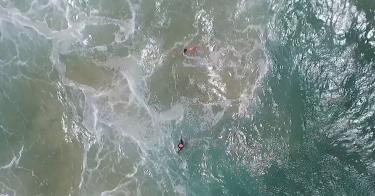In what may be a world first, Australian lifeguards last week used a drone aircraft to rescue two young swimmers trapped in dangerous swells half a mile offshore. The rescue came as lifeguards were testing the new drone.
When the lifeguard operating the drone received word of swimmers in peril, he piloted the drone to their location and dropped a “rescue pod” to them. The pod inflated when it hit the water, allowing the swimmers to get safely back to the beach.
Perhaps the only thing more extraordinary than the rescue itself—executed in just 70 seconds, besting human lifeguards by critical minutes—was that the drone apparently was unveiled to the public only that morning.
Not bad for a first day on the job.
For years, analysts and advocates have talked about the revolutionary potential of drones—a potential that extends far beyond the current popular fixations on hobby flying and package delivery. The past few months have borne them out, as operators put drones to increasingly complex and vital tasks.
After Hurricane Harvey unleashed historic flooding on Houston last year, the Federal Aviation Administration issued 137 authorizations for drones to operate in the disaster area. It did so again when Florida was wracked by Hurricane Irma and Puerto Rico by Hurricane Maria.
In the midst of these tragedies, drones ably demonstrated their value. Officials used them to execute search and rescue missions, locating people trapped and lacking supplies. They sent drones into areas otherwise inaccessible, to help accurately map disaster areas and survey damage to roads, bridges, and the electric grid.
Private companies and utility operators used drones to survey their own equipment, helping to prioritize repairs necessary to restore critical services.
Cellular service providers found great uses for drones as well, and not only to inspect cell towers for damage. In Puerto Rico, cellular service sites were wiped out across large swaths of the island. AT&T responded by using a drone it dubbed the “Flying COW,” or Cell on Wings, to replace lost equipment temporarily and restore service. Drawing power from a ground tether, the COW hovers 200 feet in the air and services a 40-square-mile area.
And of course, one cannot ignore the powerful images captured by drones, which have helped Americans to understand the scope of the devastation. As a consequence, many no doubt were compelled to volunteer or donate to disaster relief funds.
Drones demonstrated great utility outside disaster areas as well.
The California-based company Zipline has developed a highly successful partnership with the Rwandan government, allowing it to use fixed-wing drones to deliver medical supplies and blood samples throughout the African nation. What used to take hours, Zipline’s drones now can do in minutes. The company is expanding into neighboring Tanzania, bringing this life-saving technology to millions more people.
Law enforcement agencies are beginning to use drones for a variety of purposes. One example: Last year in North Carolina, the Randolph County Sheriff’s Office used a drone to survey a 40-acre field and then a cornfield, looking for a lost, elderly woman suffering from dementia. The drone found her in the cornfield within minutes.
Drones also may be used to save lives in another major way. At a congressional hearing last year on unmanned aerial systems, William Ball of the Southern Co., an energy business, testified that his industry sees drones as a means to “reduce the safety risk to our employees” by using the technology to complete dangerous tasks such as “low-altitude flight near towers, wires, and other fixed objects” in lieu of manned aircraft. A company pilot had died in just this type of situation, Ball told lawmakers.
And in dense urban airspace, the Federal Aviation Administration has recognized drones to be a safer alternative to manned aviation for some tasks. Not only are manned aircraft such as helicopters considerably larger, they carry significant quantities of highly flammable fuel. Decreasing the use of large aircraft over cities holds promise for reducing risk to both pilots and those on the ground.
To be clear, drone technology is rapidly evolving and far from mature. Many problems remain to be solved, not the least of which is development of an efficient and effective regulatory framework to govern drone operations. That process has moved at a glacial pace in recent years, chilling innovation and allowing foreign manufacturers to take the lead in this crucial space.
To begin to rectify this dynamic, the Trump administration last year announced a program to expedite wide-scale drone use in the United States, while allowing state and local governments to partner with federal aviation officials to develop reasonable rules. This is a step in the right direction, but for the industry to flourish it will need a clear, predictable, federalism-based regulatory environment.
Drone technology has reached a turning point. The life-saving potential of drones is no longer theoretical, it is tangible—and it is time for policymakers to let them soar.
This piece originally appeared in The Daily Signal



